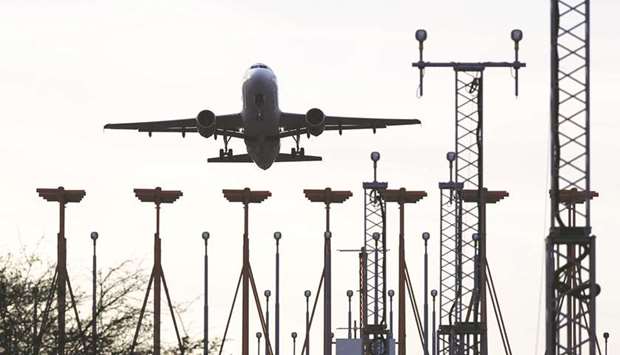Climate change is already happening. Temperatures are rising, drought and wild fires are starting to occur more frequently, rainfall patterns are shifting, glaciers and snow are melting and the global mean sea level is rising.
Increased heat, drought and insect outbreaks, all linked to climate change, have increased wildfires. Declining water supplies, reduced agricultural yields, health impacts in cities due to heat, and flooding and erosion in coastal areas are additional concerns.
The Paris Agreement is a legally binding international treaty on climate change. Its goal is to limit global warming to well below 2, preferably to 1.5 degrees Celsius, compared to pre-industrial levels.
To achieve this long-term temperature goal, countries aim to reach global peaking of greenhouse gas emissions as soon as possible to achieve a climate neutral world by mid-century.
The global aviation industry produces around 2% of all human-induced carbon dioxide (CO2) emissions.
Worldwide, commercial flights produced 915mn tonnes of CO2 in 2019, according to the Air Transport Action Group (ATAG).
IATA says its member airlines and the wider aviation industry are collectively committed to ambitious emissions reduction goals. Sustainable Aviation Fuels (SAF) have been identified as one of the key elements in helping achieve these goals.
In 2016, governments around the world have adopted CORSIAor Carbon Offsetting and Reduction Scheme for International Aviation to stabilise net carbon dioxide (CO2) emissions from international aviation from 2021.
The scheme was agreed by some 192 countries through the UN’s aviation agency. It is significant because of the aviation sector’s large and rapidly increasing CO2 emissions.
It is anticipated that CORSIA will mitigate around 2.5bn tonnes of CO2 between 2021 and 2035, which is an annual average of 164mn tonnes of CO2. This is equivalent to the total annual CO2 emissions from the Netherlands across all sectors.
CORSIA has applied to international aviation since January 2019 when all airlines were required to report their CO2 emissions on an annual basis and targets “carbon neutral” growth in international flights after 2020.
The scheme is the result of the aviation industry’s four-pillar climate strategy and goal for carbon-neutral growth from 2020.
In 2008, the industry became the first global business sector to set ambitious targets for carbon emissions: first, to improve fuel efficiency per passengers by 1.5% annually to 2020.
Second, to cap emissions through carbon-neutral growth from 2020, and third, to cut net CO2 emissions 50% by 2050 compared to 2005 level.
According to IATA’s outgoing director-general and CEO Alexandre de Juniac, “these targets are ambitious but realistic, provided governments work with industry.”
He said the basis for achieving the targets is a four-pillar strategy. Two pillars are the responsibility of industry – introducing new technology and improving the efficiency of operations.
The third pillar, better use of infrastructure, requires partnership with governments, especially in the area of air traffic management.
The fourth pillar, a market-based measure, requires governments to make a commitment to a single global mechanism for reporting and mitigating airline carbon emissions.
The mechanism became CORSIA, and it was adopted by governments at the International Civil Aviation Organisation (ICAO) in 2016.
At least 78 states have volunteered for the first phase of CORSIA, from 2021, with it becoming mandatory from 2027.
The most recent estimates compiled by IATA indicate that emissions in 2020 could drop to 250mn tonnes of CO2, which corresponds to the level of emissions some 25 years ago.
The average of the actual emissions in 2019 and 2020 was thought to be the equivalent of the sector’s total emissions in 2010.
As a result, the CORSIA baseline would be about 30% more stringent than it would have been without the Covid-19 crisis.
Industry experts say CORSIA is crucial to achieving carbon-neutral growth.
Offsetting, through which airlines invest in carbon-reduction projects in other sectors of the economy, is a long-established and respected method for ensuring climate finance is directed towards the most innovative and effective methods for reducing carbon emissions. Through offsetting, the industry hopes it can cap its net emissions at 2020 levels, until technology levels create the conditions to reduce aircraft emissions at source.
But border closures, flight restrictions, travel advisories, and social distancing measures implemented in response to the global pandemic have resulted in an unprecedented decline in aviation activity.
Such a severe shock to the international air transport system was not anticipated when CORSIA was developed a few years ago with a view to reducing global emissions.
Alternative fuels, particularly sustainable aviation fuels (SAF), have been identified as excellent candidates for helping achieve the industry climate targets.
SAF derived sources such as algae, jatropha, or waste by-products have been shown to reduce the carbon footprint of aviation fuel by up to 80% over their full lifecycle.
Over 250,000 flights have taken to the skies using SAF since 2016, IATA data reveal. About 40mn litres of SAF would have been produced in 2020, representing 0.015% of total jet fuel.
* Pratap John is Business Editor at Gulf Times. Twitter handle: @PratapJohn

An aircraft approaches the runway at Luton airport near Luton, UK. IATA says its member airlines and the wider aviation industry are collectively committed to ambitious emissions reduction goals. Sustainable Aviation Fuels (SAF) have been identified as one of the key elements in helping achieve these goals.



